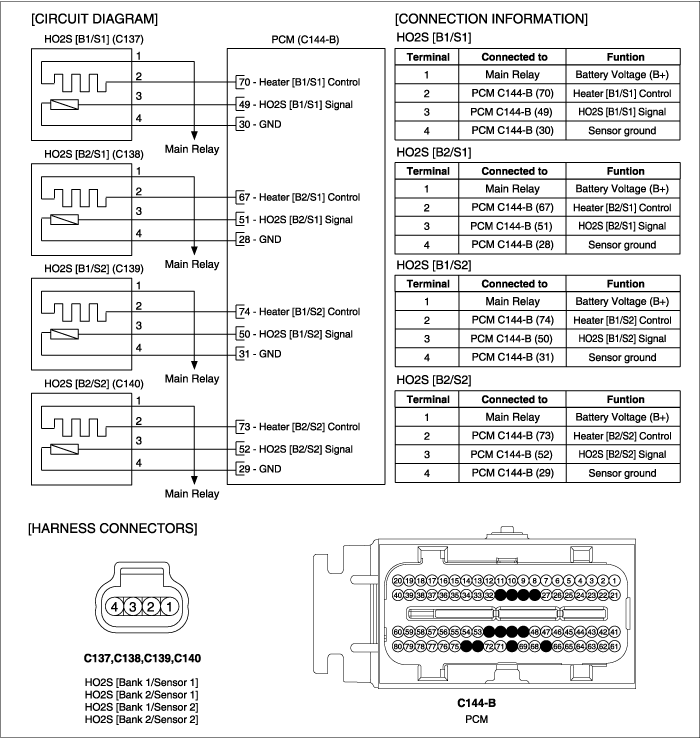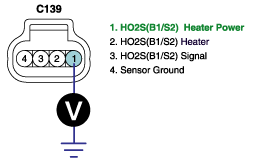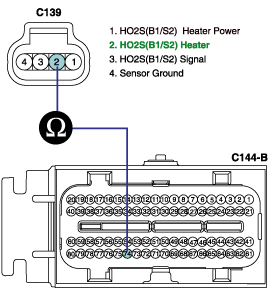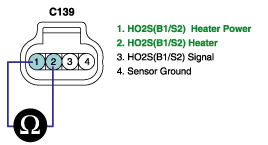Monitor "HO2S(B1/S2)" status on the service data.


The rear heated oxygen sensor is mounted on the rear side of the Catalytic Converter which is able to detect the catalyst efficiency. The rear heated oxygen sensor (HO2S) produces a voltage between 0V and 1V. This rear heated oxygen sensor is used to estimate the oxygen storage capability. If a catalyst has good conversion properties, the oxygen fluctuations are smoothed by the oxygen storage capacity of the catalyst. If the conversion provided by the catalyst is low due to aging, poisoning or misfiring, then the oxygen fluctuations are similar to signals from the front oxygen sensor.
If the HO2S heater output voltage is lower than threshold value for more than 5 seconds while enable condition is met. PCM determines that a fault exists and a DTC is stored. MIL(Malfunction Indication Lamp) turns on when the malfunction lasts till consecutive 2 driving cycle.
Item | Detecting Condition | Possible cause | |||||
DTC Strategy | ● Detects a short to ground or open circuit of O2 sensor heater circuit output | ● Poor Connection ● Open in Power Circuit ● Open or short to ground in control circuit ● HO2S(B1/S2) ● PCM | |||||
Enable Conditions | ● No disabling Faults Present ● Engine Running ● 11V ≤ Ignition Voltage ≤ 16V ● Enable Time delay ≥ 0.5sec | ||||||
Threshold value | ● short to ground or open circuit | ||||||
Diagnosis Time | ● Continuous (More than 5 seconds failure for every 10 seconds test ) | ||||||
MIL On Condition | ● 2 Driving Cycles | ||||||

The HO2S requires a minimum temperature to provide a closed loop fuel control system. So the HO2S contains a heater element to reduce its warm-up time and ensure its performance during all driving conditions. The PCM controls this heater element by duty cycle. The main relay supplies voltage to the heater and the PCM provides a ground circuit for activating the heater.
Heater | |||||||
Resistance (Ω) | 9.6 ± 1.5 | ||||||

IG "OFF" & connect scantool.
ENG "ON" and warm -up the engine to normal operating temperature.
Monitor "HO2S(B1/S2)" status on the service data.

Is the "HO2S Heater(B1/S2)" data displayed correctly ?

▶ Fault is intermittent caused by poor contact in the sensor’s and/or PCM’s connector or was repaired and PCM memory was not cleared. Thoroughly check connectors for looseness, poor connection, ending, corrosion, contamination, deterioration, or damage. Repair or replace as necessary and go to "Verification of Vehicle Repair" procedure

▶ Go to "Terminal and Connector Inspection" procedure
Many malfunctions in the electrical system are caused by poor harness and terminals.
Faults can also be caused by interference from other electrical systems, and mechanical or chemical damage.
Thoroughly check connectors for looseness, poor connection, bending, corrosion, contamination, deterioration, or damage.
Has a problem been found?

▶ Repair as necessary and go to "Verification of Vehicle Repair" procedure

▶ Go to " Power Circuit Inspection " procedure
IG "OFF" & Disconnect HO2S(B1/S2) connector.
IG "ON" & ENG "OFF".
Measure voltage between terminal 1 of HO2S(B1/S2) harness connector and chassis ground.
Specification : B+

Is the measured voltage within specification ?

▶ Go to HO2S(B1/S2) heater "Control Circuit Inspection" procedure.

▶ Repair open or short to ground in HO2S(B1/S2) Heater power circuit then, go to "Verification of Vehicle Repair" procedure.
Check short to ground in harness.
IG "OFF" and disconnect HO2S(B1/S2) connector.
Measure resistance between terminal 2 of HO2S(B1/S2) harness connector and chassis ground.
Specification : Infinite

Is the measured resistance within specification ?

▶ Go to HO2S(B1/S2) "Check Open in harness" as follows.

▶ Repair short to ground in HO2S (B1/S2) heater control circuit and go to "Verification of Vehicle Repair" procedure.
Check open in harness
IG "OFF" and disconnect HO2S(B1/S2) and PCM connector.
Measure resistance between terminal 2 of HO2S(B1/S2) harness connector and terminal 74 of PCM harness connector.
Specification : Approx. below 1Ω

Is the measured resistance within specification ?

▶ Go to HO2S(B1/S2) "Component Inspection" procedure.

▶ Repair open in HO2S(B1/S2) heater control circuit and go to "Verifiction of Vehicle Repair" procedure.
Check HO2S(B1/S2) Heater resistance
IG "OFF" and disconnect HO2S(B1/S2) connector
Measure resistance between terminal 1 and 2 of HO2S(B1/S2)(Component Side)
Heater | |||||||
Resistance (Ω) | 9.6 ± 1.5 | ||||||

Is the measured resistance within specification ?

▶ Substitute with a known - good PCM and check for proper operation. If the problem is corrected, replace PCM and go to "Verification of Vehicle Repair" procedure.
There is a memory reset function on scantool that can erase optional parts automatically detected and memorized by PCM.
Before or after testing PCM on the vehicle, use this function to reuse the PCM on the others.

▶ Substitute with a known - good HO2S(B1/S2) and check for proper operation. If the problem is corrected, replace HO2S(B1/S2) and go to "Verification of Vehicle Repair" procedure.
After a repair, it is essential to verify that the fault has been corrected.
Monitor and record the Freeze Frame Data for the Diagnostic Trouble Code(DTC) which has been diagnosed.
Using a Scantool, Clear the DTCs
Operate the vehicle within conditions noted in the freeze frame data or enable conditions
Monitor that all rediness test have been verified as " Complete "
Are any DTCs present ?

▶ Go to the applicable troubleshoooting procedure.

▶ System is performing to specification at this time.